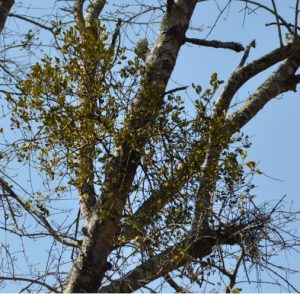By – Gary Ickes II – Ickes Tree Service, Inc.
 In our urban forest it is not uncommon to notice mistletoe growing in our trees. Mistletoe affects many species of trees in south Alabama and can be an indicator of an unhealthy tree and lead to further decline. The most common plants affected are in the oak family. Water and laurel oaks are both common urban trees that are highly susceptible to mistletoe. Mistletoe is not common in all species of oaks for example in the eighteen years that I have practiced arboriculture, I have seen mistletoe in live oaks only a handful of times. Outlined are factors that contribute to the occurrence of mistletoe and will provide some basic management and control recommendations, in this article.
In our urban forest it is not uncommon to notice mistletoe growing in our trees. Mistletoe affects many species of trees in south Alabama and can be an indicator of an unhealthy tree and lead to further decline. The most common plants affected are in the oak family. Water and laurel oaks are both common urban trees that are highly susceptible to mistletoe. Mistletoe is not common in all species of oaks for example in the eighteen years that I have practiced arboriculture, I have seen mistletoe in live oaks only a handful of times. Outlined are factors that contribute to the occurrence of mistletoe and will provide some basic management and control recommendations, in this article.
Mistletoe is an evergreen plant that reproduces with berries that provide forage for birds. The berries of
mistletoe are spread to and within trees by gravity, wind, and birds. Birds distribute the berries by passing the berries though its digestive system leaving droppings, eaten and regurgitated, or by wiping the uneaten berries from its beak on a susceptible plant part. The berry then sprouts and starts to grow.
Mistletoe is a semi-parasitic plant that forms a pseudo root system into the trees cambium layer. (The cambium is a part of the tree that acts like a vascular system moving nutrients and is responsible for much of the trees growth.) Mistletoe is considered semi-parasitic because it contains its own chlorophyll for photosynthesis, however, its pseudo root system acts in much the same way as a tree’s root system. It absorbs minerals, nutrients, and water to be used in photosynthesis to produce sugars necessary for growth. Essentially mistletoe is drawing these nutrients produced by the host tree and uses them for its own growth much like the host tree draws these nutrients from the soil.
When mistletoe pulls nutrients and water from the cambium layer of the tree it reduces the amount that can reach the tree’s foliage at the end of the limb. When water and nutrients are reduced to the foliage, it causes an imbalance and the affected area weakens and dies. The section of the limb outside of the mistletoe
dies because of an inability to produce enough sugars to survive.
As the volume of mistletoe increases in the tree and the tree becomes increasingly stressed there are additional problems that can develop. Stress opens the tree to secondary diseases and/or pests such as Hypoxylon Canker or Ambrosia beetles. Trees rarely die because of mistletoe but rather the secondary
agents. The sooner that mistletoe is treated the better the results.
Mistletoe usually grows on stressed trees. Trees can become stressed for a variety of reasons in the urban
environment. The best method to protect trees from mistletoe is to manage and minimize this stress. The urban
environment is a harsh place for trees to survive. Urban soils are generally compacted, low in organic content and may contain a variety of foreign building materials that can change to soil PH. The first step towards healthy trees and low incidents of mistletoe is stress management in trees. Good urban tree management begins by creating an environment that has soil with low compaction, proper levels of nutrients, minerals, organic matter, and water. In arboriculture mulch and mulching around trees is the closest you can come to finding the silver bullet that contributes towards healthy trees.
Once mistletoe becomes established in trees, it must be removed manually. A tree care company
with an International Society of Arboriculture (ISA) Certified Arborist on staff should be contacted to
remove the mistletoe and start to manage the tree’s stresses. The amount of mistletoe, how long the
mistletoe has been in the tree, and the amount of tree stress will determine the types and effects of treatment. Treatment may not be suitable for all trees.
An I.S.A. Certified Arborist should be able to determine whether to treat or remove the tree. As with any
company that you allow to work on your property, you should always obtain certificates of insurance directly
from their insurance agent and references. This will ensure that the individual has the proper insurances that protect you from any accidents or injuries or damage to your property that may occur during the job on your property.
I submitted this article to ACES. Beau Brodbeck and Jack Rowe rewrote and published ANR-1454.
